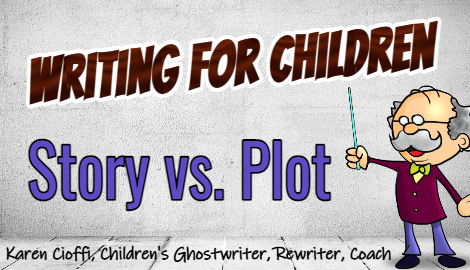I’m sure you’ve heard the words ‘story’ and ‘plot’ thrown around.
Do you know the difference between the two elements and their importance?
Understanding their differences is particularly important in children’s stories, where simplicity and clarity are essential.
So, let’s get into how these two story elements function within children’s literature.
DEFINITIONS AND CORE CONCEPTS
Story in children's literature refers to what your story is about in a chronological sequence of events and actions that make up the narrative.
It includes everything that happens, from the background and setting to the conclusion.
Plot, however, gets you from A to Z. From the beginning to the end of the story.
It’s how these events are arranged and presented to the reader—the deliberate organization of events, the pacing, and the cause-and-effect relationships—that make the story compelling and understandable.
KEY DIFFERENCES IN CHILDREN’S STORIES
Chronology vs. Structure:
Story: The story is usually straightforward and chronological in children’s literature.
Take the fairy tale "Cinderella." It begins with her life of hardship, follows her magical transformation and trip to the ball, and ends with her happy marriage.
Plot: The plot might include flashbacks to Cinderella's past or foreshadowing elements like her fairy godmother's warnings, but it remains primarily straightforward to maintain clarity for young readers.
Including ‘Outside the Detailed Narrative’ Elements:
Story: Includes all background information and events that shape the characters and setting.
In "The Very Hungry Caterpillar" by Eric Carle, the story includes the caterpillar’s entire life cycle, even though not every moment is conveyed.
Plot: Focuses on key events that move the narrative forward.
In “The Very Hungry Caterpillar,” the plot highlights the caterpillar’s daily eating habits, which leads to its transformation into a butterfly.
Emphasis on Cause and Effect:
Story: Children's stories often involve simple, clear sequences of events.
The story of "Goldilocks and the Three Bears" involves Goldilocks exploring the bears’ home and their return in a straightforward manner.
Plot: Emphasizes why Goldilocks explores the house and the consequences of her actions. This creates a cause-and-effect relationship that teaches children about curiosity and respect for others' property.
Emotional and Thematic Impact:
Story: Provides the content and the lessons inserted within the narrative.
"Where the Wild Things Are" by Maurice Sendak tells the story of Max's journey to an island of wild creatures and his return home.
Plot: Arranges the events to boost the emotional impact, showing Max's growth and realization of the importance of home.
The plot emphasizes Max's emotional journey, making the theme of love and belonging more touching for children.
EXAMPLES IN CHILDREN’S LITERATURE
"Charlotte's Web" by E.B. White:
Story: Tells the story of a young pig named Wilbur who lives in a barn with a spider named Charlotte. The pig is to be slaughtered, and Charlotte decides to save his life.
The chronological sequence includes Wilbur’s birth, his friendship with Charlotte, the events at the county fair, and Charlotte’s death.
Plot: The plot focuses on key moments like Charlotte’s decision to save Wilbur, her creation of the spun web messages, and the climax at the fair.
All these events are arranged to build suspense and highlight themes of friendship and sacrifice.
"Harry Potter and the Philosopher’s Stone" by J.K. Rowling:
Story: Covers Harry’s life from his discovery of being a wizard to his first year at Hogwarts, including various adventures and discoveries.
Plot: The plot deliberately reveals information, starting with Harry's mundane life with the Dursleys and gradually introducing the magical world, building to the climax where Harry faces Voldemort.
This arrangement maintains engagement and underscores themes of bravery and discovery.
"Goodnight Moon" by Margaret Wise Brown:
Story: A simple series of bedtime rituals in a child's room.
Plot: The plot’s repetitive and rhythmic structure helps children wind down, emphasizing the comfort and security of routine and building a soothing, predictable narrative flow.
The Interrelationship of Story and Plot in Children's Stories
In children's literature, the interrelationship between story and plot is crucial. The story provides the framework, while the plot shapes how that story is delivered to make it engaging and meaningful for young readers.
A well-constructed plot can simplify complex stories, highlight important lessons, and make narratives memorable.
For example, in "The Gruffalo" by Julia Donaldson, the story follows a mouse's journey through the woods and his encounters with various predators.
The mouse outwits predators by inventing a fearsome creature. This plot’s clever structure engages children through repetition and surprise, reinforcing themes of intelligence and resourcefulness.
SUMMING IT UP
Distinguishing between story and plot in children's stories is essential for creating engaging and educational narratives.
The story provides the events, while the plot arranges these events to enhance understanding, emotional significance, and thematic impact. By mastering this distinction, authors can craft children's stories that are entertaining, meaningful, and instructive.

I’m a working children’s ghostwriter, rewriter, editor, and coach. I can help turn your story into a book you’ll be proud to be the author of, one that’s publishable and marketable.
OTHER HELP I OFFER:
HOW TO WRITE A CHILDREN’S FICTION BOOK
A DIY book to help you write your own children’s book.
PICTURE BOOK AND CHAPTER BOOK COACHING
Four to ten-week coaching programs.
WRITERS ON THE MOVE PRESS.
Self-publishing help for children’s authors.
You can contact me at: kcioffiventrice@gmail.com. Or give me a call at 347—834—6700. (Please leave a message- I’ll get back to you as soon as I can.)


Love the clear explanations and detail. Would you be willing to let me repost “Story vs. Plot in Children’s Stories” on the Writing Advice page of Writer Advice, http://www.writeradvice.com? Of course I’ll give you and your website credit. Could be a win-win.
Thanks,
B. Lynn Goodwin
http://www.writeradvice.com
Lynn, absolutely! I’d love for you to share it.